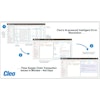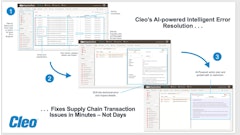Pharma company adopting TAGSYS radio frequency ID infrastructure to combat counterfeiting with item-level tags and readers
Doylestown, PA — January 13, 2006 — Pharmaceutical giant Pfizer has tapped radio frequency identification solution provider TAGSYS to assist in designing and integrating an end-to-end RFID production infrastructure to help authenticate all Viagra sold in the United States.
The infrastructure, intended to protect the pharmaceutical supply chain and, ultimately consumers, from counterfeit and black marketed drugs, will encompass item-level and case and pallet RFID.
The TAGSYS solution will encompass the solution provider's P3: e-Xecute RFID methodology and so-called "Reliable, Accurate and Secure" (R.A.S.) high-frequency (HF) 13.56 MHz RFID readers and Flexible Module tags.
Meeting FDA Guidelines
Following feasibility studies conducted by the U.S. Food and Drug Administration (FDA) around RFID, the agency released guidelines and recommendations for the use of the technology to ensure the long-term safety and integrity of the U.S. drug supply.
In line with this guidance from the FDA, Pfizer has been at the forefront of evaluating the usage of RFID on product packaging to track, trace and authenticate products as they move through the value chain distribution system. The Viagra packaging project marks the first time that Pfizer will be deploying RFID at an item level.
Achieving a Low Failure Rate
One of the key considerations in the deployment of RFID by Pfizer is the ability to produce fast, reliable, accurate and secure readings with a very low failure rate. Pfizer tapped TAGSYS' RFID solutions because of their ability to meet the stringent demands of the industry for accuracy, speed and interoperability, according to the solution provider.
TAGSYS said its HF RFID readers used by Pfizer can read up to 400 tags in a dense pack setting, even around liquids and metal surfaces, in a matter of seconds, with an industry leading accuracy rate of over 99.9 percent.
"The Viagra project is a major milestone for item-level RFID in the pharmaceutical industry and can be viewed as a significant precursor to establishing the long anticipated e-Pedigree," said Elie Simon, CEO of TAGSYS. "By tagging individual bottles of Viagra, Pfizer is taking some very positive steps to further secure the pharmaceutical supply chain."
Since its inception in 1996, TAGSYS has focused on the development of HF RFID technology and creating specific solutions for vertical markets that are ready to adopt item-level RFID. The company offers RFID chips, tags, antennas, readers, software and integration.
Additional Articles of Interest
— A recent independent study revealed that Wal-Mart customers are finding the items they wanted in stock more often due to the retailer's use of RFID technologies when compared to control stores. Read more in "Wal-Mart Achieving Improved On-shelf Availability with RFID, Study Finds" on SDCExec.com.
— Consumers spent nearly $28 billion on the "Black Friday" after Thanksgiving 2005, up 21.9 percent over 2004's results. Great news for retailers, but a potential nightmare for supply chain executives trying to get the right product on the right shelf at the right time. The lesson: Now is the time to plan for the next peak shipping season. Read more in the "Seasons' Peakings," the Executive Memo column in the December 2005/January 2006 issue of Supply & Demand Chain Executive.
— Leading crafts company Creativity Inc. has found that, with a bit of trust and a lot of teamwork, a little consulting can go a long way in addressing supply chain pain points. Read more in "Crafting Success in Supply Chain Transformation," cover story in the December 2005/January 2006 issue of Supply & Demand Chain Executive.
Doylestown, PA — January 13, 2006 — Pharmaceutical giant Pfizer has tapped radio frequency identification solution provider TAGSYS to assist in designing and integrating an end-to-end RFID production infrastructure to help authenticate all Viagra sold in the United States.
The infrastructure, intended to protect the pharmaceutical supply chain and, ultimately consumers, from counterfeit and black marketed drugs, will encompass item-level and case and pallet RFID.
The TAGSYS solution will encompass the solution provider's P3: e-Xecute RFID methodology and so-called "Reliable, Accurate and Secure" (R.A.S.) high-frequency (HF) 13.56 MHz RFID readers and Flexible Module tags.
Meeting FDA Guidelines
Following feasibility studies conducted by the U.S. Food and Drug Administration (FDA) around RFID, the agency released guidelines and recommendations for the use of the technology to ensure the long-term safety and integrity of the U.S. drug supply.
In line with this guidance from the FDA, Pfizer has been at the forefront of evaluating the usage of RFID on product packaging to track, trace and authenticate products as they move through the value chain distribution system. The Viagra packaging project marks the first time that Pfizer will be deploying RFID at an item level.
Achieving a Low Failure Rate
One of the key considerations in the deployment of RFID by Pfizer is the ability to produce fast, reliable, accurate and secure readings with a very low failure rate. Pfizer tapped TAGSYS' RFID solutions because of their ability to meet the stringent demands of the industry for accuracy, speed and interoperability, according to the solution provider.
TAGSYS said its HF RFID readers used by Pfizer can read up to 400 tags in a dense pack setting, even around liquids and metal surfaces, in a matter of seconds, with an industry leading accuracy rate of over 99.9 percent.
"The Viagra project is a major milestone for item-level RFID in the pharmaceutical industry and can be viewed as a significant precursor to establishing the long anticipated e-Pedigree," said Elie Simon, CEO of TAGSYS. "By tagging individual bottles of Viagra, Pfizer is taking some very positive steps to further secure the pharmaceutical supply chain."
Since its inception in 1996, TAGSYS has focused on the development of HF RFID technology and creating specific solutions for vertical markets that are ready to adopt item-level RFID. The company offers RFID chips, tags, antennas, readers, software and integration.
Additional Articles of Interest
— A recent independent study revealed that Wal-Mart customers are finding the items they wanted in stock more often due to the retailer's use of RFID technologies when compared to control stores. Read more in "Wal-Mart Achieving Improved On-shelf Availability with RFID, Study Finds" on SDCExec.com.
— Consumers spent nearly $28 billion on the "Black Friday" after Thanksgiving 2005, up 21.9 percent over 2004's results. Great news for retailers, but a potential nightmare for supply chain executives trying to get the right product on the right shelf at the right time. The lesson: Now is the time to plan for the next peak shipping season. Read more in the "Seasons' Peakings," the Executive Memo column in the December 2005/January 2006 issue of Supply & Demand Chain Executive.
— Leading crafts company Creativity Inc. has found that, with a bit of trust and a lot of teamwork, a little consulting can go a long way in addressing supply chain pain points. Read more in "Crafting Success in Supply Chain Transformation," cover story in the December 2005/January 2006 issue of Supply & Demand Chain Executive.
- More articles about TAGSYS.

















